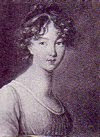
The Benevolent School
English School
Bristol City Museum and Art Gallery
Bristol, England
Image from The Bridgeman Art Library
I love this piece of art because it is simple, charming, fascinating and dates from the late 18th century, possibly early 19th century.* I have not seen it in person nor can I find out much more about it so I cannot list its dimensions, etc. I also cannot get a really close look at what everyone is doing in it in spite of zoom features on two of the sites where it is available. I think one of the girls may be knitting at the top of the picture and two woman may be winding wool in the foreground. Nevertheless, it is fun to follow the line of pupils and instructors around the room and look at the hats and bonnets on the walls and the view of the building outside of the window.
Click on the image for a larger version.
*I seem to recall the date of 1800 assigned to this but I cannot remember where I read that, and that date may be one of creation rather than representation.










